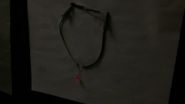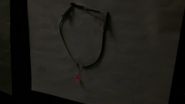(Press-News.org) VIDEO:
Dr. Thomas and his team light an LED using energy stored in the outside coatings of an electrical cable.
Click here for more information.
Imagine being able to carry all the juice you needed to power your MP3 player, smartphone and electric car in the fabric of your jacket?
Sounds like science fiction, but it may become a reality thanks to breakthrough technology developed at a University of Central Florida research lab.
So far electrical cables are used only to transmit electricity. However, nanotechnology scientist and professor Jayan Thomas and his Ph.D. student Zenan Yu have developed a way to both transmit and store electricity in a single lightweight copper wire.
Their work is the focus of the cover story of the June 30 issue of the material science journal Advanced Materials and science magazine, Nature has published a detailed discussion about this technology in the current issue.
"It's a very interesting idea," Thomas said. "When we did it and started talking about it, everyone we talked to said, "Hmm, never thought of that. It's unique.'"
Copper wire is the starting point but eventually, Thomas said, as the technology improves, special fibers could also be developed with nanostructures to conduct and store energy.
More immediate applications could be seen in the design and development of electrical vehicles, space-launch vehicles and portable electronic devices. By being able to store and conduct energy on the same wire, heavy, space-consuming batteries could become a thing of the past. It is possible to further miniaturize the electronic devices or the space that has been previously used for batteries could be used for other purposes. In the case of launch vehicles, that could potentially lighten the load, making launches less costly, Thomas said.
So how did he get the idea about energy-storing cables? He was inspired during a routine evening walk in his neighborhood.
Thomas and his team began with a single copper wire. Then they grew a layer of nanowhiskers on the outer surface of the copper wire. These whiskers were then treated with a special alloy, which created an electrode. Two electrodes are needed for the powerful energy storage. So they had to figure out a way to create a second electrode.
They did it- this by adding a very thin plastic sheet around the whiskers and wrapping it around using a metal sheath (the second electrode) after generating nanowhiskers on it (the second electrode and outer covering). The layers were then glued together with a special gel. Because, of the insulationthe nanowhisker layer is insulating, the inner copper wire retains its ability to channel electricity, the layers around the wire independently store powerful energy.
In other words, Thomas and his team created a supercapacitor on the outside of the copper wire. Supercapcitors store powerful energy, like that needed to start a vehicle or heavy-construction equipment.
Although more work needs to be done, Thomas said the technique should be transferable to other types of materials. That could lead to specially treated clothing fibers being able to hold enough power for big tasks. For example, if flexible solar cells and these fibers were used in tandem to make a jacket, it could be used independently to power electronic gadgets and other devices.
"It's very exciting," Thomas said. "We take it step by step. I love getting to the lab everyday, and seeing what we can come up with next. Sometimes things don't work out, but even those failures teach us a lot of things. Still, I know how important getting out of the lab can be too. I won't be giving up those evening walks anytime soon. I get some great ideas during that quiet time."
INFORMATION:
Yu is the co-author of the study. He works in Thomas' Nano Energy-Photonics Group. It conducts research focused primarily on nanostructured supercapacitors and Lithiuim-ion batteries, nanoarchitectured light-trapping solar cells, photorefractive polymers for 3D display applications, and nonlinear optical materials.
Thomas is a faculty member at the UCF Nanoscience Technology Center with joint appointments in the College of Optics and Photonics (CREOL) and the College of Engineering and Computer Science. He has multiple degrees including a master's degree in chemistry and a Ph.D. in material science. He is a recipient of National Science Foundation's prestigious CAREER award. He's received media attention over the past few years for his work on lasers and advanced nanomaterials.
America's Partnership University: The University of Central Florida, the nation's second-largest university with nearly 60,000 students, has grown in size, quality, diversity and reputation in its first 50 years. Today, the university offers more than 200 degree programs at its main campus in Orlando and more than a dozen other locations. UCF is an economic engine attracting and supporting industries vital to the region's future while providing students with real-world experiences that help them succeed after graduation. For more information, visit http://today.ucf.edu.
Breakthrough in energy storage: Electrical cables that can store energy
New nanotech may provide power storage in electric cables, clothes
2014-06-02
ELSE PRESS RELEASES FROM THIS DATE:
Common cholesterol drug greatly alters inflammatory response to common cold
2014-06-02
Cold season may be just behind us, but a new discovery may shed light on how this common condition triggers asthma attacks. In a new research report published in the June 2014 issue of the Journal of Leukocyte Biology, researchers show that in individuals with asthma, statins significantly reduce the in vitro inflammatory response of human monocytes to rhinovirus (RV), the cause of the common cold. Not only does this discovery suggest that statins could help prevent or reduce the severity of asthma symptoms resulting from colds, but may also open the doors to further research ...
Why some experimental forms of 'The Pill for Males' will never rise to the occasion
2014-06-02
It appears that "The Pill" for men will have to wait a while longer. A new research report published in the June 2014 issue of The FASEB Journal involving mice, shows that a previously developed male hormonal oral contraceptive method (i.e. via testosterone) is unable to stop the production and / or the release of sperm.
"Our research in mice explains why the efficacy of male hormonal contraception is not as effective as expected and it provides clues on how to improve the method," said Ilpo Huhtaniemi, M.D., Ph.D., M.D.hc, FMed.Sci., a researcher involved in the work ...
Early steps toward personalized fitness: Interval training may benefit men more than women
2014-06-02
When it comes to reaping benefits of sprint interval training, it appears that men have won the battle of the sexes, if just barely. According to new research published in the June 2014 issue of The FASEB Journal, men create more new proteins as a result of this exercise than women do. The good news, however, is that men and women experienced similar increases in aerobic capacity. This study is the first to directly measure the creation of proteins made to adapt to this mode of exercise. The study also uniquely used methods that measure the cumulative making of proteins ...
Nano-platform ready: Scientists use DNA origami to create 2D structures
2014-06-02
Scientists at New York University and the University of Melbourne have developed a method using DNA origami to turn one-dimensional nano materials into two dimensions. Their breakthrough, published in the latest issue of the journal Nature Nanotechnology, offers the potential to enhance fiber optics and electronic devices by reducing their size and increasing their speed.
"We can now take linear nano-materials and direct how they are organized in two dimensions, using a DNA origami platform to create any number of shapes," explains NYU Chemistry Professor Nadrian Seeman, ...
Study finds that suicides are far more likely to occur after midnight
2014-06-02
DARIEN, IL – A new study provides novel evidence suggesting that suicides are far more likely to occur between midnight and 4 a.m. than during the daytime or evening.
Results show that the weighted, scaled mean suicide rate per hour was 10.27 percent after midnight, peaking at 16.27 percent between 2 a.m. and 2:59 a.m. In contrast, the mean suicide rate per hour was 2.13 percent between 6 a.m. and 11:59 p.m. When six-hour time blocks were examined, the observed frequency of suicide between midnight and 5:59 a.m. was 3.6 times higher than expected.
"This appears to ...
Antipsychotic medication during pregnancy does affect babies, study shows
2014-06-02
A seven-year study of women who take antipsychotic medication while pregnant, proves it can affect babies.
The observational study, published in the journal PLOS ONE, reveals that whilst most women gave birth to healthy babies, the use of mood stabilisers or higher doses of antipsychotics during pregnancy increased the need for special care after birth with 43 per cent of babies placed in a Special Care Nursery (SCN) or a Neonatal Intensive Care Unit (NICU), almost three times the national rate in Australia.
As well as an increased likelihood of the need for intensive ...
Neuron tells stem cells to grow new neurons
2014-06-02
DURHAM, N.C. -- Duke researchers have found a new type of neuron in the adult brain that is capable of telling stem cells to make more new neurons. Though the experiments are in their early stages, the finding opens the tantalizing possibility that the brain may be able to repair itself from within.
Neuroscientists have suspected for some time that the brain has some capacity to direct the manufacturing of new neurons, but it was difficult to determine where these instructions are coming from, explains Chay Kuo, M.D. Ph.D., an assistant professor of cell biology, neurobiology ...
Hypnosis extends restorative slow-wave sleep
2014-06-02
Sleeping well is a crucial factor contributing to our physical and mental restoration. SWS in particular has a positive impact for instance on memory and the functioning of the immune system. During periods of SWS, growth hormones are secreted, cell repair is promoted and the defence system is stimulated. If you feel sick or have had a hard working day, you often simply want to get some good, deep sleep. A wish that you can't influence through your own will – so the widely held preconception.
Sleep researchers from the Universities of Zurich and Fribourg now prove ...
Poor sleep equal to binge drinking, marijuana use in predicting academic problems
2014-06-02
DARIEN, IL – A new study shows that college students who are poor sleepers are much more likely to earn worse grades and withdraw from a course than healthy sleeping peers.
Results show that sleep timing and maintenance problems in college students are a strong predictor of academic problems even after controlling for other factors that contribute to academic success, such as clinical depression, feeling isolated, and diagnosis with a learning disability or chronic health issue. The study also found that sleep problems have about the same impact on grade point average ...
NUS scientists demonstrate rare chemical phenomenon to harvest solar energy
2014-06-02
A team of international scientists led by Professor Jagadese J Vittal of the Department of Chemistry at the National University of Singapore's (NUS) Faculty of Science has successfully unraveled the chemical reaction responsible for propelling microscopic crystals to leap distances up to hundreds of times their own size when they are exposed to ultraviolet (UV) light.
This popping effect, akin to the bursting of popcorn kernels at high temperatures, demonstrates the conversion of light into mechanical motion. It is the first instance of a "photosalient effect" driven ...
LAST 30 PRESS RELEASES:
Numbers in our sights affect how we perceive space
SIMJ announces global collaborative book project in commemoration of its 75th anniversary
Air pollution exposure and birth weight
Obstructive sleep apnea risk and mental health conditions among older adults
How talking slows eye movements behind the wheel
The Ceramic Society of Japan’s Oxoate Ceramics Research Association launches new international book project
Heart-brain connection: international study reveals the role of the vagus nerve in keeping the heart young
Researchers identify Rb1 as a predictive biomarker for a new therapeutic strategy in some breast cancers
Survey reveals ethical gaps slowing AI adoption in pediatric surgery
Stimulant ADHD medications work differently than thought
AI overestimates how smart people are, according to HSE economists
HSE researchers create genome-wide map of quadruplexes
Scientists boost cell "powerhouses" to burn more calories
Automatic label checking: The missing step in making reliable medical AI
Low daily alcohol intake linked to 50% heightened mouth cancer risk in India
American Meteorological Society announces Rick Spinrad as 2026 President-Elect
Biomass-based carbon capture spotlighted in newly released global climate webinar recording
Illuminating invisible nano pollutants: advanced bioimaging tracks the full journey of emerging nanoscale contaminants in living systems
How does age affect recovery from spinal cord injury?
Novel AI tool offers prognosis for patients with head and neck cancer
Fathers’ microplastic exposure tied to their children’s metabolic problems
Research validates laboratory model for studying high-grade serous ovarian cancer
SIR 2026 delivers transformative breakthroughs in minimally invasive medicine to improve patient care
Stem Cell Reports most downloaded papers of 2025 highlight the breadth and impact of stem cell research
Oxford-led study estimates NHS spends around 3% of its primary and secondary care budget on the health impacts of heat and cold in England
A researcher’s long quest leads to a smart composite breakthrough
Urban wild bees act as “microbial sensors” of city health.
New study finds where you live affects recovery after a hip fracture
Forecasting the impact of fully automated vehicle adoption on US road traffic injuries
Alcohol-related hospitalizations from 2016 to 2022
[Press-News.org] Breakthrough in energy storage: Electrical cables that can store energyNew nanotech may provide power storage in electric cables, clothes




